The performance of Indian cotton spinners is likely to weaken in fiscal 2019-20, following a brief recovery in the last fiscal, as they grapple with weak export demand and uncompetitive cotton prices, according to an ICRA report, which observed a de-growth in volumes due to lower export demand and a sharper decline in realisations vis-a-vis cotton prices.
Probable improvements, dependent on world cotton output, China’s policies on cotton stocking and imports and the US-China trade war because of higher minimum support price (MSP)-led floor price for cotton are expected to result in a decline in turnover and an estimated 100-150 bps compression in operating profitability of domestic cotton spinners during the 2019-20, according to the report.
“Based on the emerging trends, we have revised the credit outlook on the Indian cotton spinning industry to 'Negative,' as the profitability and debt coverage metrics are expected to moderate from the current levels. The impact is likely to be more pronounced for leveraged companies, that have undertaken a sizeable debt-funded capital expansion in the recent years and have higher repayments scheduled in the near term,” said Jayanta Roy, senior vice president and group head, corporate sector ratings, ICRA.
A large proportion of spinners have not undertaken capacity expansions in recent years, given the not-so-encouraging demand trends during this period, coupled with the discontinuance of subsidy benefits under the government’s Technology Upgradation Fund Scheme (TUFS) for the spinning segment.
This has resulted in a consistent decline in term borrowings for such companies in recent years with scheduled debt repayments, due to which the impact on their debt coverage metrics and liquidity could be lower, despite industry pressures, according to the report.
With India exporting roughly one-third of its cotton yarn production every year, trends in export demand play a crucial role in determining the overall performance of the domestic spinning sector. India’s cotton yarn export quantity declined by 33per cent year-on-year (YoY) in the first quarter of 2019-20 (41 per cent in May and June 2019) and stood at a seven-year low of 59 million kg in June 2019.
As a result, multiple textile associations across the country have reported stock pile-ups and production cuts by spinning mills in recent months. Whereas markets other than China, which has been the largest cotton yarn market for India, had supported the demand during 2016-17 and 2017-18 when exports to China fell, the pressure is more broad-based now.
As compared to a 50 per cent YoY decline in cotton yarn exports to China during the first quarter of 2019-20, exports to other markets too declined by around 20 per cent.
“The pressure is primarily originating from higher cotton prices in the domestic market, which has made Indian yarn manufacturers uncompetitive in the international markets. As a result, the near-term outlook on Indian cotton yarn exports is quite weak at present”, Roy added.
Weakened competitiveness of domestic spinners is corroborated by the fact that India’s cotton yarn exports to China declined in the first quarter of 2019-20, even though China’s cotton yarn import volumes remained range bound. In contrast to the domestic trend, wherein cotton fibre prices firmed up during the quarter ended June 2019 owing to a shortage of cotton availability, international cotton prices corrected at a sharp pace.
This was driven by a higher-than-average global cotton stock-to-use ratio, as lower consumption arrested the pace of decline in the global cotton stocks, and healthy crop expectations for CYg2020 (refers to global cotton year ending July 2020).
Besides uncompetitive cotton prices, other factors which have been affecting cotton yarn exports from India include a duty-free access provided by China to Pakistan from July 2019 onwards, continued competitive pressures from nations like Vietnam, and higher cotton fibre imports by China, which is keeping its cotton availability comfortable and cotton fibre prices competitive.
In addition, imposition of tariffs by the United States on garment exports from China is affecting China’s apparel exports, in turn slowing down the demand for cotton yarn.
The impact on profitability of domestic cotton spinners is expected to be seen in the first half of 2019-20, particularly during the second quarter, as yarn realisations started correcting from July 2019 onwards after remaining firm during the first quarter. (DS)
Πηγή: fibre2fashion

